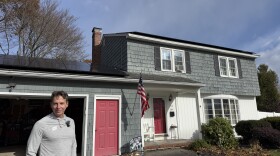Scientists at the University of New Hampshire are studying ways to tap trees and make syrup with species other than maples, in hopes of developing new niche markets for small producers as climate change reshapes the state’s current sugaring industry.
The researchers have been tapping and monitoring trees like beeches, birches, walnuts and sycamores this winter.
During a webinar Thursday, UNH Forestry Program coordinator Heidi Asbjornsen described the current syrup industry as “essentially a monoculture,” which relies on the success of a single type of tree.
“This research is really focusing on diversification of the syrup industry … both ecologically and economically,” she said.
Leading the niche syrup project is graduate researcher David Moore, himself a former producer of birch and sycamore syrups. He said they want to understand what conditions drive sap flow in these species, and their practical potential to produce syrup.
So far, Moore said, they’ve found that sap flows in most of these trees in response to freeze-thaw cycles, like maples. Some tend to run at different times than maple, or for shorter periods.
Moore said birches, especially paper birches, begin producing useful sap around the end of maple sugaring season, amid slightly warmer, sunnier weather conditions. The birch sugar season lasts for two to three weeks, compared to six to eight weeks for maples.
UNH Extension forester Steven Roberge said birch syrup has the most established market after maples, with many producers in Alaska and Canada and a handful in the Northeast. Some on the research team said it was their favorite flavor, too – tending to be less sweet and more nutty than maple syrup.
Roberge said birch syrup is not a regional "commodity" like maple syrup in New England yet, but he's heard of bartenders using it as a novel local cocktail ingredient.
"People that I know who've produced birch syrup - they really had to hustle a bit and find those markets locally," he said. "I think someone who's creative can kind of figure out what the flavors are and the notes and actually sell it that way."
Walnut sap, Moore said, appears to runs around the same time as maple sap. And some sap-producing trees haven’t proven useful for sugaring at all. Moore said they haven’t had great success yet with hickory, ash or poplar trees.

And some species that do produce successful syrup do so in very particular conditions, he said – requiring careful material handling or temperatures to avoid bad flavors in the finished product.
Still, Moore wants to keep trying as many species as possible. He said he’ll try to get syrup out of pretty much any tree he can – even, once, fresh-cut hickory and ash firewood at his home.
“I noticed some sap bleeding from out of the end of the log,” he said. “I actually went over and tasted them and they were really good, really sweet from both of them, so that gave me hope that maybe these two species could be used eventually as well."
Moore said his favorite syrup comes from sycamore trees, which sometimes produce a lighter flavor like honey or butterscotch, and sometimes tend darker like maples do.
He said sycamores seem to produce more sap after unseasonably warm days in spring and winter, or after heavy rains. Both conditions are becoming more common in New Hampshire due to climate change.
The warming trend is expected to put stress on New Hampshire’s maple trees, even as it creates conditions more favorable to sap production. On the other hand, beeches are twice as common in New Hampshire as maples, said Roberge.
"There's a lot of potential if something takes off with that, that these trees are available for us to use and it creates a really broad landbase where we could actually harvest that sap," he said.
This summer, Moore said, the team will analyze the sap they collect this season to understand its chemical makeup, including any healthy, medicinal or poisonous attributes that may come from different trees. They plan to compile more data on successful processing methods in hopes of aiding producers.








